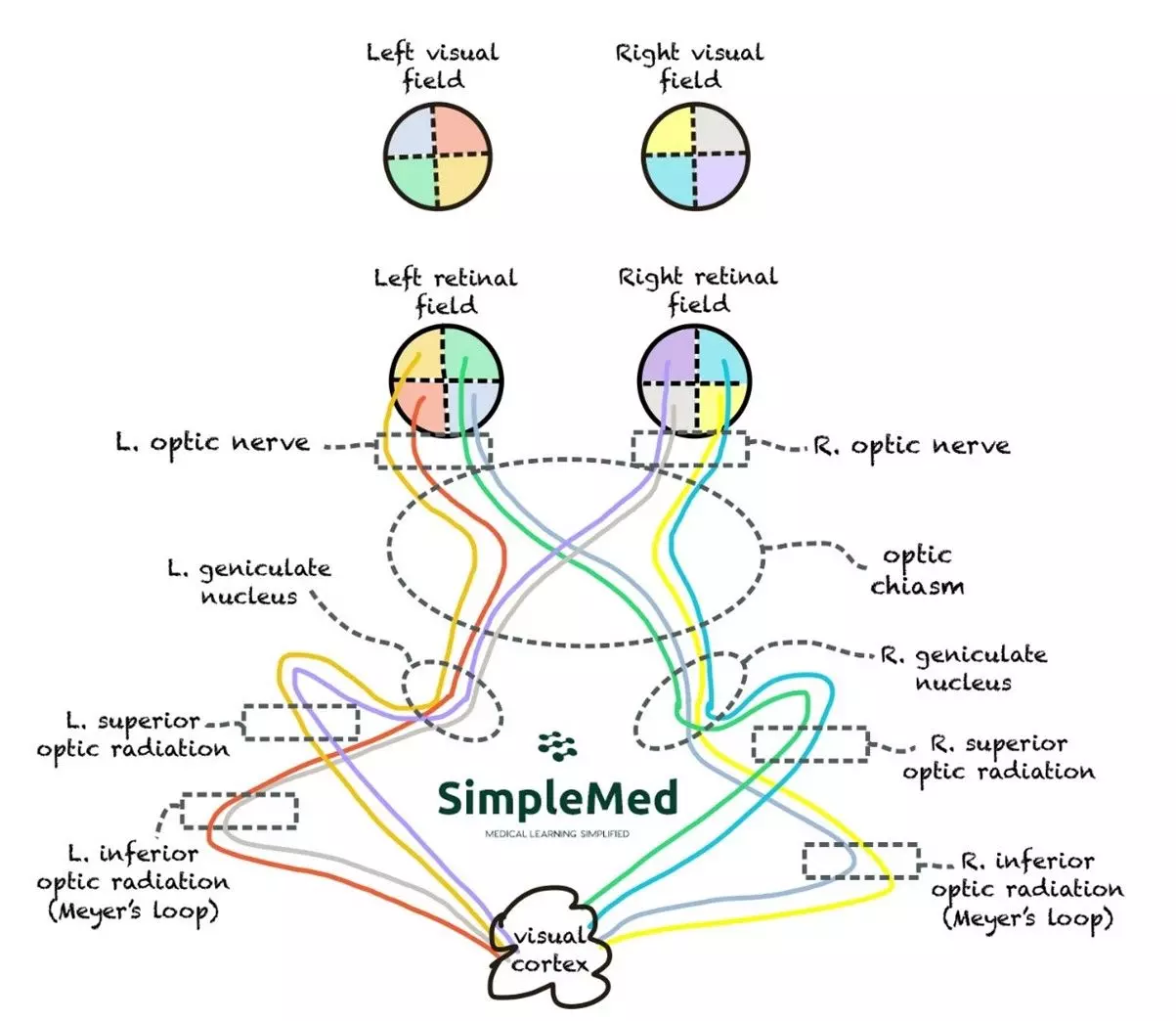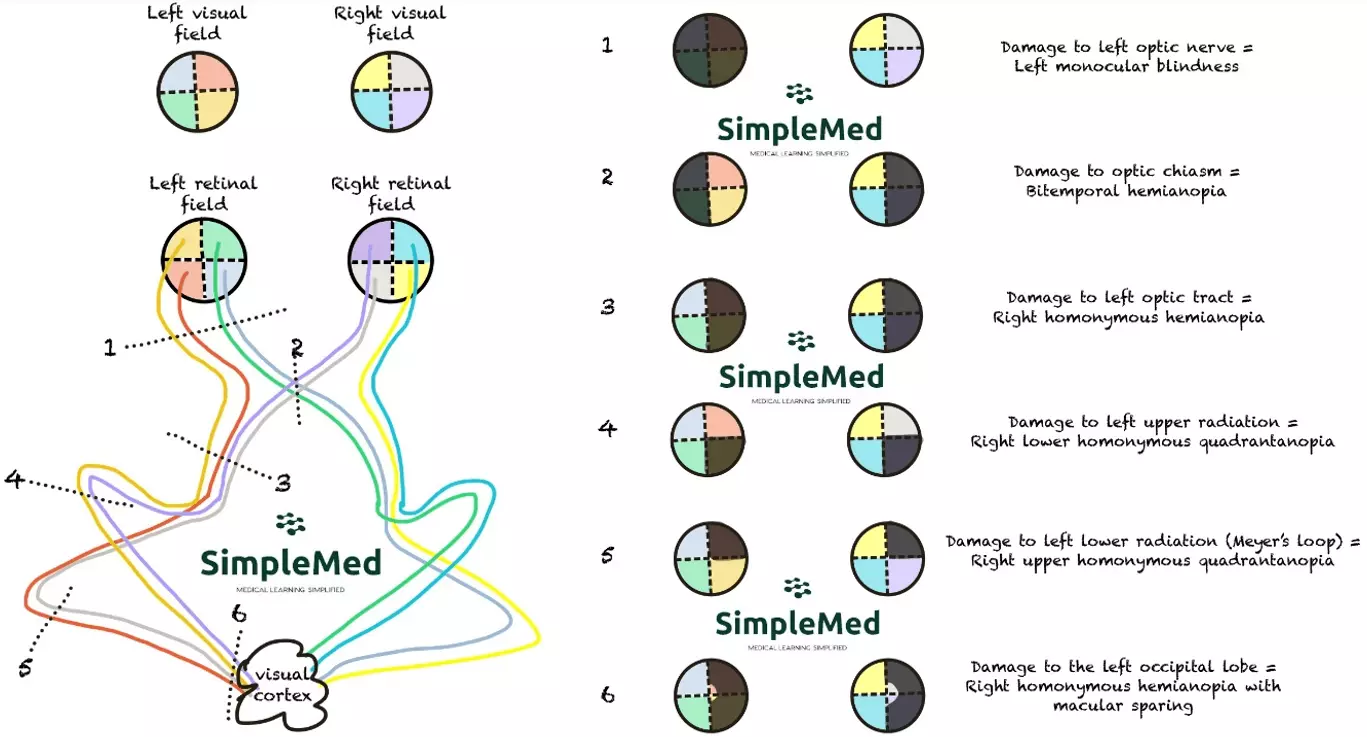Next Lesson - Higher Cortical Function
Abstract
- The visual pathway carries visual sensory information from the retinae to the optic nerves to the chiasm where the optic nerves reconfigure into the optic tracts that further branch into optic radiations at the lateral geniculate nuclei, which, in turn, reach the visual cortex.
- Damage at different levels of the visual pathway results in specific visual field defects which can help in localising lesions.
Core
To understand the visual pathway, the first thing to understand is the anatomy of the eye. For more information about the anatomy of the eyeball, please see the article 'The Eye' in our Head and Neck series.
The outermost layer of the eyeball is known as the sclera, and it is formed of a continuous sheath of dura from the optic nerve (CNII). Next, is the middle layer or vascular layer, known as the uvea and it comprises the iris and ciliary body anteriorly and the choroid posteriorly.
Finally, the innermost layer, is the neural layer, or retina and it comprises retinal pigment epithelium, photoreceptor cells, and bipolar cells.
Optical coherence tomography (OCT) is the imaging technique used to visualise the layers of the retina and can therefore be used to visualise damage to the retina.
The trajectory of light through the eye is a very important concept to understand before considering the visual pathway. The eye is like a pinhole camera: light from the lateral visual field is directed towards the medial retina and light from an upper visual field is directed towards the lower retina. To help prevent confusion surrounding words like medial and lateral between the two eyes, medial is more often described as nasal and lateral as temporal.
All of this means that the projection of what the eye sees is basically flipped upside down and flipped left to right on our retina. The image transferred to the visual cortex is therefore upside down and back to front.
The basic optic pathway is as follows: retina -> optic nerve -> optic chiasm -> optic tracts -> lateral geniculate nucleus -> optic radiations -> visual cortex of the occipital lobe.
From the retina, the optic nerve leaves the orbit via the optic canal, which is found on the sphenoid and in the middle cranial fossa. The optic nerves from both eyes meet in the centre of the skull to form the optic chiasm; this occurs just above the pituitary gland.
Within the optic chiasm, fibres from the nasal half of each retina cross over to the contralateral optic tract, whereas the fibres from the temporal half of each retina remain ipsilateral (on their original side). So, the left optic tract comprises fibres from the left temporal half of the retina and fibres from the right nasal half of the retina. This means that the same image is transferred within the same optic tract – something positioned to the patient’s right side will be perceived by the right nasal retina and the left temporal retina, and these images will both be transmitted down the left optic tract. The exact opposite goes for the right optic tract.
The optic tracts project from the optic chiasm to a part of the thalamus known as the lateral geniculate nuclei. There is a left and a right lateral geniculate nucleus. At this level, the optic tracts branch into superior and inferior optic radiations where fibres from the superior half of the retina (inferior visual field) travel as the superior optic radiation through the parietal lobe to the visual cortex, and fibres from the inferior half of the retina (superior visual field) travel as the inferior optic radiation, also referred to as Meyer’s loop, through the temporal lobe to the visual cortex.
These can be quite confusing, but a summary is:
- Inferior visual field – superior optic radiation – parietal lobe
- Superior visual field – inferior optic radiation – temporal lobe
Some people find this mnemonic helpful – PITS can be used to remember that the Parietal lobe has the Inferior visual field, and the Temporal lobe has the Superior visual field. This can be confusing though, because the inferior visual field is carried by the superior radiation (and this then makes the mnemonic not work…).
The optic tracts travel into the primary visual cortex in the occipital lobe.
Here is a diagrammatic representation of the pathway to help visualise it all:

Diagram - The path that information from all four quadrants of both eyes takes between the retina and the visual cortex
SimpleMed original by Elena Perez
Now, let’s apply the understanding of the visual pathway to localise lesions based on visual field defects. Injuries to the optic fibres at different levels of the pathway result in particular visual field losses and patients can often present with insidious field defects picked up during routine eye tests that lead to a diagnosis of lesions on the brain.
Visual pathway defects are always described by referring to the lost visual field (not the location of damage to the retina) and the eyes are divided into quadrants when describing these.
There are some terms that are important to understand when describing visual field defects:
- Hemianopia – lesions to the visual field where one-half of the visual field is damaged, i.e. the entire left side of the visual field of that eye is lost.
- Quadrantinopia – lesions to the visual field where one quadrant (one quarter) of the visual field is damaged.
- Homonymous – homonymous means the same, so a homonymous hemianopia would be a loss of the same half of the visual field in both eyes. However, it is important to understand that the same half is the nasal region of one eye and the temporal field of the other.
Small, localised defects in the retina that result in a blind spot that does not conform to quadrants like visual field defects normally do are known as scotomas. These can be the result of a variety of retinopathies such as diabetes, hypertension, multiple sclerosis, and others, but are not likely to be due to damage to the visual pathway itself.
Damage to the optic nerve causes monocular blindness, where vision from the whole visual field of the eye involved is lost.
Damage to the optic chiasm (most commonly caused by pituitary tumours as the pituitary gland sits below the chiasm) causes bitemporal hemianopia or tunnel vision where patients lose the lateral halves of the visual field in both eyes. This is because the nasal retinal regions (the temporal visual fields) decussate through the optic chiasm, and it is these fibres that are damaged.
Damage to the optic tract will result in a contralateral homonymous hemianopia where patients lose vision on the opposite side of the visual field to where the lesion is, i.e. if the lesion is on the left optic tract, it causes a right homonymous hemianopia, where the right half of the visual fields is lost (nasal hemianopia on the left eye and temporal hemianopia on the right eye, referred to as ‘homonymous’).
Damage to the superior optic radiations (in the parietal lobe) will result in contralateral homonymous inferior quadrantanopia e.g. if the lesion is on the left parietal (superior) radiation, it causes right homonymous inferior quadrantanopia. Similarly, damage to an inferior optic radiation will cause the opposite field defect: a superior quadrantanopia e.g. if the lesion is on the left temporal (inferior) radiation, aka left Meyer’s loop, it causes right homonymous superior quadrantanopia.
Damage to the posterior cerebral cortex from occlusion of the posterior cerebral artery will result in a contralateral homonymous hemianopia with macular sparing. This is because the area of visual cortex that corresponds to the macula is supplied by more than one artery (middle cerebral and posterior cerebral) meaning the macular will be spared due to its alternative blood supply.
Here is a diagrammatic representation of visual field defects from lesions at different levels of the visual pathway to help visualise it all:

Diagram - The visual pathways and demonstrates the visual field defects that result from different lesions
SimpleMed original by Elena Perez
In Summary
- The pathway goes retina -> optic nerve -> optic chiasm -> optic tract -> lateral geniculate ganglion -> radiations -> primary visual cortex.
- Visual fields and retinal positions are opposite – temporal upper field goes to nasal lower retina.
- Right side of the retina uses the right tract because…
- Nasal fibres decussate
- Inferior fibres use the inferior radiation (remember this is the superior portion of the visual field)….
- PITS – Parietal radiation is Inferior visual field (superior radiation) and Temporal radiation is Superior visual field (inferior radiation).
Edited by: Dr. Maddie Swannack
Reviewed by: Dr. Thomas Burnell
- 3176

